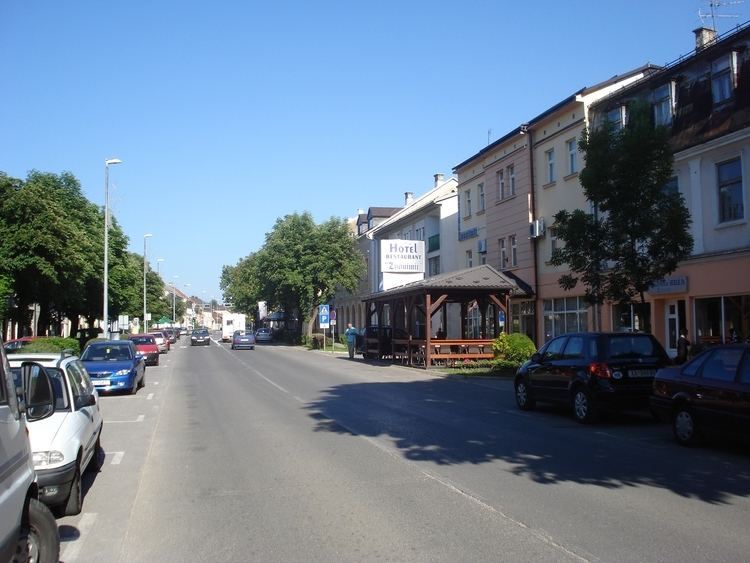Time zone CET (UTC+1) Website otocac.hr Population 4,354 (2001) Area code 053 | Postal code 53220 Area 565.3 km² Local time Monday 11:33 PM | |
 | ||
Weather 7°C, Wind E at 10 km/h, 63% Humidity | ||
Otočac ([ɔtɔ̌tʃats]; German: Ottochaz, Latin: Ottocium) is a town in Croatia, former bishopric and present Latin Catholic titular see. It lies in the northwestern part of Lika region, in the Gacka river valley. The population of the town is 4,354 as of 2001, with a total of 10,411 people within the municipality at large, the majority of whom are Croats (91%), the number having risen exponentially since the Croatian War of Independence, before which Croats comprised 65% and Serbs 31% of the town's population.
Contents
- Map of 53220 OtoC48Dac Croatia
- History
- Ecclesiastical History
- Residential Suffragan Bishops
- Titular see
- Demographics
- Geography
- Notable natives and residents
- References
Map of 53220, Oto%C4%8Dac, Croatia
History
Otočac was named after the early Croatian parish. The text of the famous Baška Tablet (around 1100) says that the church of St. Nicholas in Otočac was part of the order community with the Church of St. Lucy, Jurandvor on the island of Krk. From 1300 on, it belonged to the estate of the Frankopan family. Sigismund Frankopan (1461–1535) founded a diocese there (see below). The settlement with a defence tower, at a bend in the river Gacka, was protected by a towered fort. After the fort's demolition in 1829, only parts remained preserved. To provide a safer defence, a Renaissance-era castle ("Fortica") was built in 1619, with a triangular layout of cylindrical towers (these ruins stand above the town).
The Baroque parish church of the Holy Trinity, erected in 1684 (restored in 1774), is a large one-nave building with rounded sanctuary; three side chapels are on each side of the nave. The bell tower rises from the main front. The late baroque and classicist furnishings of the church include seven altars, a pulpit, baptismal font and sepulchral slabs from the 18th century.
From 1746, Otočac was the headquarters of a regiment (Ottotschaner Grenz-Infanterie Regiment N°II) of the Croatian Military Frontier, (Croatian Vojna Krajina). A number of harmonious, simple, mostly two-story houses originate from this period. Until 1918, Otočac (named OTTOCSAZ before 1850) was part of the Austrian monarchy (Kingdom of Croatia-Slavonia after the compromise of 1867). In the late 19th century and early 20th century, Otočac was part of the Lika-Krbava County of the Kingdom of Croatia-Slavonia.
During World War II, Otočac was part of the Independent State of Croatia. At least 331 Serbs were liquidated and an Orthodox priest, Branko Dobrosavljević, was forced to pray in front of the tortured and dying while his young son lay literally cut into pieces before his eyes. Then the priest's hair and beard were torn off, his eyes were gouged out, and he was tortured until he died.
Ecclesiastical History
A bishopric was established in 1460, on territory split off from the Roman Catholic Diocese of Senj, which local estate owner Sigismund Frankopan (1461–1535) founded at the church of St. Nicholas and Jelena (née Keglević), widow of Juraj Mikuličić, who was a member of the community of the Divine Holy Spirit in Rome, gave to the church three parcels of land. Initially it was suffragan of the Metropolitan Archdiocese of Salona, later of the Archdiocese of Split. In 1534 it was suppressed and its territory returned to its mother diocese of Senj.
Residential Suffragan Bishops
Titular see
It was nominally restored in 1933 as a titular bishopric. It had had the following incumbents, of the lowest (episcopal) rank :
Demographics
According to 2001 census, the municipality had 10,411 inhabitants, of whom 91.29% were Croats and 6.63% were Serbs. Croats in the vicinity of Otočac form two groups, those who speak Chakavian dialect and Bunjevci, who speak Shtokavian dialect with an Ikavian accent. Serbs form a majority in the villages of Gorići and Staro Selo. The town itself had population of 4,354.
Before the Croatian War of Independence, the 1991 census lists the greater municipality of Otočac as having 24,992 inhabitants, with 16,355 Croats (65.44%) and 7,781 Serbs (31.13%).
Geography
Otočac is located in the western part of the karst field of centrally located Gacka, located between Velebit and Mala Kapela, at an elevation of 459m. The town lies to the southeast of Senj, northwest of Gospić and west of Plitvice.
There are two town sections, the Upper Town and Lower Town.
